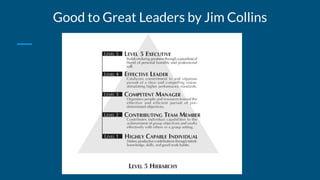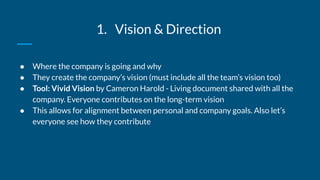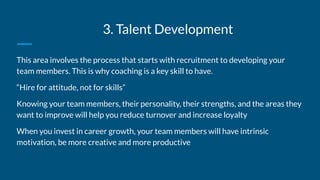Leadership (1).pdf
- 1. Leadership A process in which a person guides and influences the behavior and mindset of others in order to accomplish specific goals
- 2. Who is a leader? How is a leader different from a manager? What makes a great leader?
- 3. Good to Great Leaders by Jim Collins
- 5. Level 5 Leadership 1. Creating more leaders - setting up the company for success 2. “WE-centric” instead of “I-centric” — Window & Mirror 3. Reachable, almost ordinary people producing extraordinary results 4. Ferocious resolve to do what needs to be done - inspires standards, not charisma 5. Channels ambition into the company, not the self.
- 6. The 3 Elements of Great Leadership A great manager helps people become more effective in their job and to grow and develop. Support + Respect + Trust
- 7. Everyday Leadership 1. Talent Management 2. Staff Meetings & 1-on-1s 3. Problem Solving Using First Principles 4. Communication & Conflict Management 5. A Culture of Innovation
- 8. 1. Vision & Direction ● Where the company is going and why ● They create the company’s vision (must include all the team’s vision too) ● Tool: Vivid Vision by Cameron Harold - Living document shared with all the company. Everyone contributes on the long-term vision ● This allows for alignment between personal and company goals. Also let’s everyone see how they contribute
- 9. 2. Communication ● VALUES-A leader has to find the communication values for the company, that will guide the way everyone communicates to each other ● FEEDBACK - Having a feedback culture elicits constant improvement. Also allows you to spot problems before they develop. ● CONFLICT RESOLUTION- before tensions scale (Involves emotional management). A leader has to prioritize verbal communication, specially for sensitive topics.
- 10. 3. Talent Development This area involves the process that starts with recruitment to developing your team members. This is why coaching is a key skill to have. “Hire for attitude, not for skills” Knowing your team members, their personality, their strengths, and the areas they want to improve will help you reduce turnover and increase loyalty When you invest in career growth, your team members will have intrinsic motivation, be more creative and more productive
- 11. 4. Prioritization This is a key aspect to balance company growth with employee wellbeing LERR strategy to prioritize Leverage: Is the new idea leveraging on what is already working for your business now? Ease: Is it easy enough to execute and get results? Risk: How risky is the idea? If it fails, what would you lose? Return of Investment: Will you get a return on the time and money you invest. Do, Delegate or Delete - 20% of your efforts create 80% of your results
- 12. How to know when the leadership is failing ● Lack of trust ● Fear of conflict ● Lack of clarity ● No committed action
- 13. Coaching Pods Coach a leader into creating a Vivid Vision for their company ● Say you sit and travel in a time machine 3 years into the future, The date is 31st December, 3 years into the future. ● What does your ideal life look, sound and feel like? ● Include your vision for your personal life as well as your business Person 1 - Coach Person 2 - Leader












